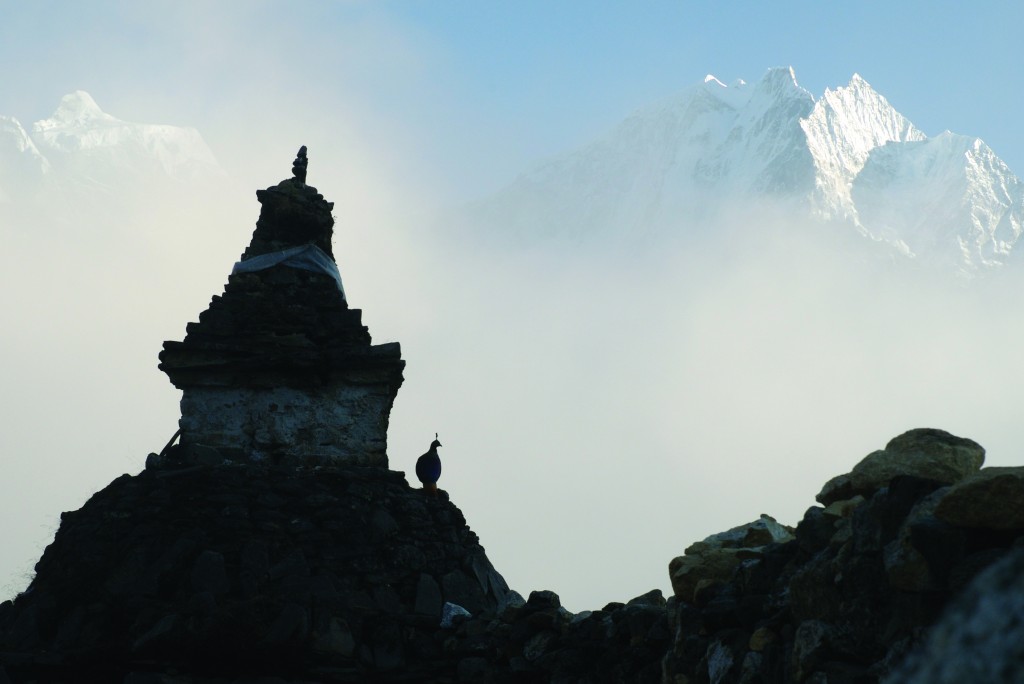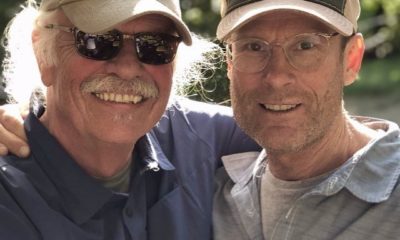Uncategorized
Flashpoint
Published
11 years agoon
Danuru Sherpa represents a new breed of Himalayan guide By Terry Cunningham Explore Big Sky Contributor Danuru Sherpa and John Dahlem’s headlamps lit the riot of wind-whipped ice pellets peppering their faces like buckshot, plinking against their oxygen masks. It was 4 a.m. on May 24, 2010, and the men were at 28,500 feet on Mount Everest’s southeast ridge. They braced themselves as another 50-mile-an-hour gust threatened to blow them tumbling 8,000 feet into Nepal. Dahlem, 67 and a retired school principal, looked back at his 34-year-old guide Danuru, who flashed a broad smile accented by a single gold tooth and motioned upward. Several steps later, Dahlem was suddenly unable to breathe. “It felt like there was a hand clamped over my mouth. I thought I was having a heart attack,” he recalls. He gestured madly to Danuru, who knew immediately what was happening. The Sherpa smacked Dahlem’s oxygen mask, knocking ice chunks from it. But he still wasn’t getting air. “Then he leaned in like he was gonna kiss me,” Dahlem says. Danuru, a native of Phortse, Nepal, placed his lips over a thin tube venting Dahlem’s oxygen mask and, with a sharp puff, blew a hunk of frozen sweat and snot back into the mask, unclogging the system. For Dahlem, standing atop Mount Everest in 2010 was a stepping stone in his goal of completing the Adventurer’s Grand Slam: surmounting the highest summit on each of the seven continents, and reaching the north and south poles. For Danuru Sherpa – who Bozeman alpinist Conrad Anker describes as “one of the two or three strongest people on [Everest]” – the goal was to earn enough money to send his daughters, now ages 13 and 11, to school in Kathmandu.

Looking toward Tengboche monastery in Phortse, Nepal, Ama Dablam in the background. Phortse is the home of the Khumbu Climbing Center, which works to reduce what co-founder Conrad Anker calls “the alarmingly high fatality rate among the native high-altitude workers.” PHOTO BY JENNIFER LOWE-ANKER
Since the late 19th century, western expeditions have employed Sherpas to haul heavy loads and establish high-altitude camps on 8,000-meter peaks including Everest, despite their lack of technical or rescue training. A significant flashpoint in the Sherpa-Westerner relationship occurred on Everest in 2013, when three European solo climbers ignored the pleas of a Sherpa rope-fixing crew not to traverse the icy slopes of the Lhotse Face above them. The Europeans then inadvertently knocked down chunks of ice toward the rope-fixers and rebuffed the Sherpas’ subsequent challenge with a deluge of vile insults. Danuru was at Camp I when a group of furious Sherpas confronted the solo climbers at Camp II. “Very angry talk,” he says of the melee in an excited tone. “[Western man] make the first punch and then big fight with fist and rock.” The brawl – which was portrayed very differently by the Westerners involved – became the subject of world headlines in the weeks that followed. “They don’t listen when we ask please wait,” Danuru said, shaking his head. “Need respect to Sherpa more. Climbing is Sherpa way to make money, change our life.” Anker is more direct. “This altercation should serve as a wake-up call for ‘Westies’ to quit treating [Sherpas] like trash and slaves.” __________ Danuru was 18 when he met Anker and Dave Hahn, both renowned American climbers now with myriad Everest summits. The year was 1999, and all three were part of the expedition that discovered famed British mountaineer George Mallory’s body on the north side of Everest. 



Danuru, pictured here with his family in Phortse, guides at high elevation to support his daughters’ education. PHOTO BY JENNIFER LOWE-ANKER
Danuru’s humility reflects a culture that values modesty and deference – something that doesn’t necessarily best serve Sherpas guiding well-heeled, type-A clients on 8,000-meter peaks. In the fall of 2002, Danuru tried to turn around slow moving Korean clients just below the Hillary Step for timing and safety concerns. “Client say: ‘We spend lots of money to come here. Almost there. We go up!’” Danuru recalls. After several calls to Base Camp, they finally heeded the Sherpa’s advice. Hahn believes Danuru has outgrown his current role as a personal guide for one or two clients at a time, and is capable of leading expeditions. “I don’t like keep working on the mountain too long, but I need to make money for education for daughters,” Danuru says with a sigh. This is also cultural, Anker says. “Their biggest investment is in their children’s education. Improving your place in life is the social bling in the Sherpa community.” Given the complex risk/reward calculus of high-altitude mountaineering, one can only hope Danuru Sherpa will know when the time is right to hang up his crampons.
This story was first published in the winter 2013/2014 issue of Mountain Outlaw magazine.
Megan Paulson is the Co-Founder and Chief Operating Officer of Outlaw Partners.


Upcoming Events
november, 2024
Event Type :
All
All
Arts
Education
Music
Other
Sports
Event Details
Spanish Classes with World Language InitiativeThese unique, no cost Spanish classes are made possible by the contribution of Yellowstone Club
more
Event Details
Spanish Classes with World Language InitiativeThese unique, no cost Spanish classes are made possible by the contribution of Yellowstone Club Community Foundation (YCCF) and Moonlight Community Foundation (MCF). This class will focus on building a lifelong affinity for world languages and cultures through dynamic and immersive Communicative Language teaching models.
Beginner Class – Mondays and Wednesdays from 5:30-6:30 pm
Intermediate Class – Mondays and Wednesdays from 6:45- 7:45 pm
- Classes begin Oct.7, 2024 and run for 6 weeks
- Class size is limited to 12 students
- Classes are held in Big Sky at the Big Sky Medical Center in the Community Room
For more information or to register follow the link below or at info@wlimt.org.
Time
October 14 (Monday) 5:30 pm - November 20 (Wednesday) 7:45 pm
Location
Big Sky Medical Center - Community Room (2nd Floor)
Big Sky Medical Center - Community Room (2nd Floor)
Event Details
Youth Basketball is available for ages K-4th. Practice (Tues/Wed) and Game (Saturdays) Schedule: - Kindergarten: Tues. 4-5pm, Sat. 9-10am - Grades 1-2: Wed.
more
Event Details
Youth Basketball is available for ages K-4th.
Practice (Tues/Wed) and Game (Saturdays) Schedule:
– Kindergarten: Tues. 4-5pm, Sat. 9-10am
– Grades 1-2: Wed. 4-5pm, Sat. 10-11am
– Grades 3-4: Wed. 5-6pm, Sat. 11a-12p
-$35 player fee
-There will be no games on 10/19
-BASE pass is required
-All game spectators must check-in at the BASE front desk
For more info, e-mail Steven at sreid@bsco.org
Time
October 15 (Tuesday) 4:00 pm - November 16 (Saturday) 12:00 pm
Location
BASE
285 Simkins Dr
Event Details
Spanish Classes with World Language InitiativeThese unique, no cost Spanish classes are made possible by the contribution of Yellowstone Club
more
Event Details
Spanish Classes with World Language InitiativeThese unique, no cost Spanish classes are made possible by the contribution of Yellowstone Club Community Foundation (YCCF) and Moonlight Community Foundation (MCF). This class will focus on building a lifelong affinity for world languages and cultures through dynamic and immersive Communicative Language teaching models.
Beginner Class – Mondays and Wednesdays from 5:30-6:30 pm
Intermediate Class – Mondays and Wednesdays from 6:45- 7:45 pm
- Classes begin Oct.7, 2024 and run for 6 weeks
- Class size is limited to 12 students
- Classes are held in Big Sky at the Big Sky Medical Center in the Community Room
For more information or to register follow the link below or at info@wlimt.org.
Time
October 21 (Monday) 5:30 pm - November 27 (Wednesday) 7:45 pm
Location
Big Sky Medical Center - Community Room (2nd Floor)
Big Sky Medical Center - Community Room (2nd Floor)









